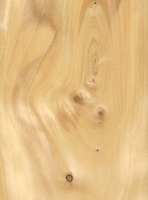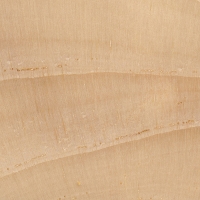 |
Common Name(s): White Spruce Scientific Name: Picea glauca Distribution: Northern North America Tree Size: 110 ft (34 m) tall, 2-3 ft (.6-1.0 m) trunk diameter Average Dried Weight: 27 lbs/ft3 (425 kg/m3) Specific Gravity (Basic, 12% MC): .33, .43 Janka Hardness: 480 lbf (2,140 N) Modulus of Rupture: 8,640 lbf/in2 (59.6 MPa) Elastic Modulus: 1,315,000 lbf/in2 (9.07 GPa) Crushing Strength: 4,730 lbf/in2 (32.6 MPa) Shrinkage: Radial: 4.7%, Tangential: 8.2%, Volumetric: 13.7%, T/R Ratio: 1.7 |
Color/Appearance: White Spruce is typically a creamy white, with a hint of yellow.
Grain/Texture: White Spruce has a fine, even texture, and a consistently straight grain.
Rot Resistance: Heartwood is rated as being slightly resistant to non-resistant to decay.
Workability: Easy to work, as long as there are no knots present. Glues and finishes well, though it can give poor (blotchy and inconsistent) results when being stained due to its closed pore structure. A sanding sealer, gel stain, or toner is recommended when coloring Spruce.
Odor: No characteristic odor.
Allergies/Toxicity: Although severe reactions are quite uncommon, Spruce in the Picea genus has been reported as a sensitizer. Usually most common reactions simply include skin irritation and/or respiratory disorders. See the articles Wood Allergies and Toxicity and Wood Dust Safety for more information.
Pricing/Availability: Construction grade spruce is cheap and easy to find. However, quartersawn clear pieces—free from knots—can be more expensive. White Spruce is occasionally used for piano soundboards, requiring clear quartersawn pieces.
Sustainability: This wood species is not listed in the CITES Appendices, and is reported by the IUCN as being a species of least concern.
Common Uses: Paper (pulpwood), construction lumber, millwork, and crates.
Comments: None.
Scans/Pictures: The samples shown below were taken from a dwarf variety of the species, which has a high number of knots, as well as irregular grain, which aren’t necessarily typical for the species.
 |
 |
 |
 |





Is the tree that you chosen a coniferous or deciduous tree?
Spruce is Coniferous like all soft woods
There are many deciduous soft woods (aspen, basswood, poplar etc)
I think it’s important to avoid confusion here over the term “softwoods” — which is generally used (without a space) as a synonym for conifers. But soft woods (with a space) would denote simply woods that are soft. That space is very important. John’s statement is technically true, but a little confusing. Aspen, basswood, and poplar are not “softwoods” — they are trees with soft wood.
Soft wood or softwood, in my world, and I harvest and sell timber off my 2,500 acres, softwoods include pines and many non-pine species including aspen, basswood etc.
This even applies to maple: “hard maple” (sugar) vs “soft maple” (red).
Softwood is not a synonym for pine in the North Woods.
John
Then there’s the term “white wood” or “whitewood” which I’ve seen refer to any pale spf and the like or exclusively referring to poplars.
Terminology and language are confusing beasts.